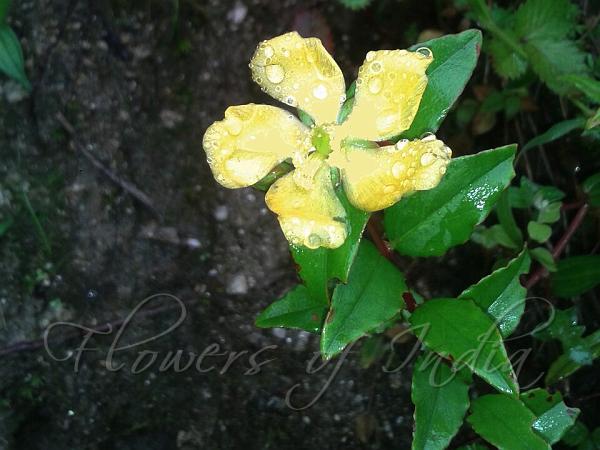|
| South-Asian Hypericum |
|

|

|
|
|
|
Photo: |
Botanical name: Hypericum hookerianum Family: Hypericaceae (Hypercum family)
Synonyms: Hypericum garrettii
Synonyms: Hypericum garrettii
South-Asian Hypericum is a shrub up to 1.75 m
tall, bushy, round-topped, branches erect to spreading. Stems are
red-brown. Leaves are carried on leaf-stalks 1-4 mm, blade narrowly
lanceshaped to oblong-lanceshaped or broadly ovate, 2.5-7.8 x 1-3.2 cm,
below paler or glaucous. Main lateral veins 3- or 4-paired, without
visible tertiary reticulation. Base is narrowly wedge-shaped to
somewhat heart-shaped, tip pointed to rounded. Flowers are borne in
1-5-flowered clusters, from apical node. Bracts are deciduous,
lanceshaped or narrowly oblong to obovate-spoon-shaped. Flower-stalks
are 3-16 mm. Flowers 3-6 cm in diameter, deeply cupped, buds broadly
ovoid to nearly spherical, tip broadly blunt to rounded. Sepals are
spreading-incurved, obovate or obovate-spoonshaped to circular or
elliptic or oblong-elliptic, nearly equal, 5-10 x 4-8 mm. Petals are
deep golden to pale yellow, broadly obovate to nearly circular, 1.5-3 x
1.5-2.5 cm, about 3 times as long as sepals, margin entire. Stamen
fascicles are each with 60-80 stamens, longest 5-9 mm, 0.25-0.35 times
as long as petals. Ovary is broadly ovoid, 5-7 x 4-5 mm; styles 2-4 mm,
0.35-0.7 times as long as ovary, free, gradually outcurved toward tip.
Capsule is ovoid to ovoid-conic, 0.9-1.7 cm x 7-12 mm. Seeds are dark
reddish brown, 0.7-1 mm. South-Asian Hypericum is found in the
Himalayas in Bhutan, NE India, Myanmar, Nepal, N Thailand, N Vietnam,
at altitudes of 1900-3400 m. Flowering: April-July.
| Identification credit: Nongthombam Ullysess | Photographed in Dirang, Arunachal Pradesh. |
• Is this flower misidentified? If yes,